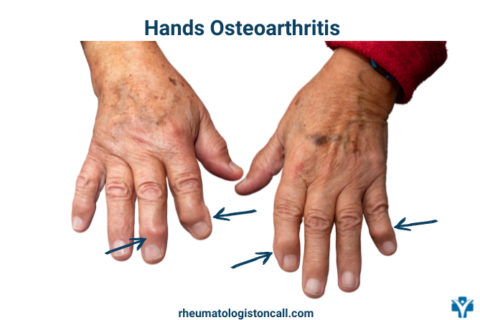SHARE
Treating hand osteoarthritis at home can be safe and efficient. Living with osteoarthritis can be difficult at time. However, you might not need to see a rheumatologist if some of these options are working for your pain. Today, I have seen another patient that presented to my office for pain in her hands. After taking a detailed history, I told the patient that she has osteoarthritis of the hands. Then many questions followed.
What is osteoarthritis?
It is the most common form of arthritis, also known as “wear and tear” arthritis. It can involve almost all joints, but the hands are one of the joints most commonly affected. Women develop osteoarthritis of the hands more often than men.
What is causing osteoarthritis of the hands?
Initially, rheumatologists believed that only mechanical factors and overuse contribute to this process. More recently, researchers showed that some pro-inflammatory factors appear to drive the production of some proteolytic enzymes responsible for joint tissue destruction.
How does it manifest?

The most common manifestation is pain in the hands that is worsened by movement and relieved by rest. The thumb is frequently affected. Hand mobility is restricted. The last two joints of the phalanx can have bony deformities that can be painful to touch. There is no redness, and the joints are not warm to the touch.
Will X-rays be needed to diagnose osteoarthritis?
X-rays are not necessary most of the time if the clinical picture is clear and there are no severe limitations in the hands’ mobility. However, if severe osteoarthritis is detected and surgery is considered, X-ras can be beneficial. They can show specific changes such as bony growth (called “osteophytes”) joint space narrowing, subchondral sclerosis, and bony cysts.
How to treat hands osteoarthritis at home?
You should treat when you have pain. However, it would be best if you worked on maintaining the function of the hand intact by continuing to use the hands. Here are a few options for treatment at home:

- Splinting: most times, the thumb is the most painful joint of the hand. A thumb spica splint (#ad) wore for a few weeks will minimize the pain. If you have pain in the wrist, wear a wrist brace (#ad), especially at night, to put your joints in a neutral position.
- Voltaren gel (#ad, diclofenac gel) is an excellent anti-inflammatory product, finally approved in the US as an over-the-counter medication. The benefit of using an anti-inflammatory gel as a local therapy is vast since this is a targeted therapy. Voltaren gel works great on small joints and has minimal systemic side effects compared to oral NSAIDs. It can be used safely in adequate amounts, even for patients with kidney disease, since minimal blood absorption. Here is a tip: make sure you massage it very well into your joints until you don’t feel it anymore on your skin. You can apply it even 3x/ day.
- Paraffin wax bath: the heat maintained by the paraffin wax will help your pain and make your skin look great. Consider searching online for one or you may consider this product: Paraffin bath (#ad)
- Exercises:maybe it sounds weird, but stretching exercises are beneficial in releasing stiffness and pain. Exercises will strengthen your muscles and improve the function of your hands. Use a rubber ball and start by squeezing it slowly. You may consider this option: Hand grip strengthener (#ad)
- Injections with steroids: only recommended if the pain does not subside with all the other interventions.
For more information, read our following blogs, where I will discuss other types of arthritis. If your pain does not resolve, consider asking an arthritis specialist.
About the Author
 Diana Girnita, MD, PhD is an US board certified internal medicine and rheumatology. She completed a PhD in immunology, postdoctoral fellowship at Harvard University, immunology fellowship at University of Pittsburgh and rheumatology fellowship at University of Cincinnati. She is the founder & CEO of Rheumatologist OnCall, a telemedicine company that serves multiple states in the US. Dr. Girnita is a graduate of the Nutrition Science course from Stanford University. Dr. Girnita was recognized many times with “Top Doctor” award (2017-2020) and is frequently invited speaker of the US National Arthritis Foundation. Read more
Diana Girnita, MD, PhD is an US board certified internal medicine and rheumatology. She completed a PhD in immunology, postdoctoral fellowship at Harvard University, immunology fellowship at University of Pittsburgh and rheumatology fellowship at University of Cincinnati. She is the founder & CEO of Rheumatologist OnCall, a telemedicine company that serves multiple states in the US. Dr. Girnita is a graduate of the Nutrition Science course from Stanford University. Dr. Girnita was recognized many times with “Top Doctor” award (2017-2020) and is frequently invited speaker of the US National Arthritis Foundation. Read more














